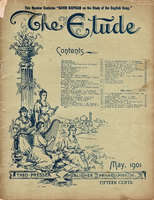Music-study classes and analytical lectures of all sorts are almost too common now to be written about, but I would like to relate a pleasant experience I have had in this line, one which bids fair to bear good fruit in the future, and I believe help to increase the attendance at good concerts, as well as the making of appreciative listeners.
Some years ago before such music clubs and lectures were thought of, except in the larger cities of the East, I felt the necessity of rousing the musical interest of my pupils. The town in which I lived was small; there were few musicians, and very few fine concerts, as they never paid. It seemed to me there was a chance for missionary work in this field. I gathered together my older pupils, invited possibly a dozen, music-loving, but musically-ignorant, ladies, to join us.
We formed ourselves into a club, meeting every two weeks during that winter. I gave short lectures on musical history and biography, with musical analysis. Before the season ended we had some really fine concerts, and I had the pleasure of seeing every member of my class at every concert, interested listeners.
In the summer I went abroad for an indefinite time, and at the end of five years returned to America, and to this same locality. To my regret I found it really less musical than at first. The city had grown wonderfully. Clubs of all kinds—literature, every art but music—had made giant strides. Plenty of teachers, plenty of pupils, but no musical atmosphere, no interest, one musician wouldn’t speak to another; the state of affairs reminded me of that threadbare conundrum: “What is a musical slur?” “What one musician says of another!”
One day, one of my old pupils came to me and said: “Why won’t you give a course of lectures on music this winter? There are a dozen of us ready and anxious to come; make it a business affair, and there are others who will gladly join.”
The idea of the class pleased me, I missed the musical atmosphere I had lived in so long, and welcomed this as really a help to myself. We never stand still, we either go forward or back, and study helps the musician.
I made the course twelve lectures, meeting every fortnight, the price being merely nominal. I was delighted to find some gentlemen, businessmen, had joined; I have found when one can introduce a little social element, one can do much better; it is a strong power not to be overlooked.
In arranging my first lecture I endeavored to offer my facts, dates, and historical matter in homeopathic doses, well sweetened, in the “Rise of Music,” I had Greek poems, hymns to illustrate it, closing with the “Rise of the Christian Church.” I saw the class would listen for the music, so I determined to shorten the talk to a half-hour, the rest of the time to be passed at the piano, where I really talk more than my hearers realize, as the music interests them.
I confess to a little scheme: I have seated one lady quite near me, I watch her while I talk, and on first sign of uneasiness I bring the talk to an end. I find it an excellent gauge.
After my first lecture I was enabled to form a second class. The second topic was “Folk-song, and the Minnesingers,” illustrating vocally with old songs of different nations. Number three was “Oratorio,” with organ accompaniment; then came “Rise of Opera.” Here I wavered; how to demonstrate whole operas I didn’t know, but a friend came to the rescue with an orchestrella, and the class really obtained an excellent knowledge of parts of old and new music dramas.
Now, the “Orchestra” is very important, and I took great pains with that. I obtained pictures of every instrument in the orchestra, and these were passed through the class, while I explained the instrument. I also made diagrams of the seating of a large orchestra. The class were deeply interested, and they have since expressed their pleasure at being able to recognize all instruments. If one has not pictures, an illustrated catalogue of “Orchestral Instruments” can be had at any music dealers; cut out these pictures, paste them on stiff cardboard, and then you have the entire set.
At the last class we had “Rise of Instrumental Music,” analysis of the symphony and sonata, music from the fifteenth, sixteenth, seventeenth, and eighteenth centuries. The remaining six lectures will be devoted to individual composers and their style, and I intend giving some extra evenings on Wagner.—M. J.



